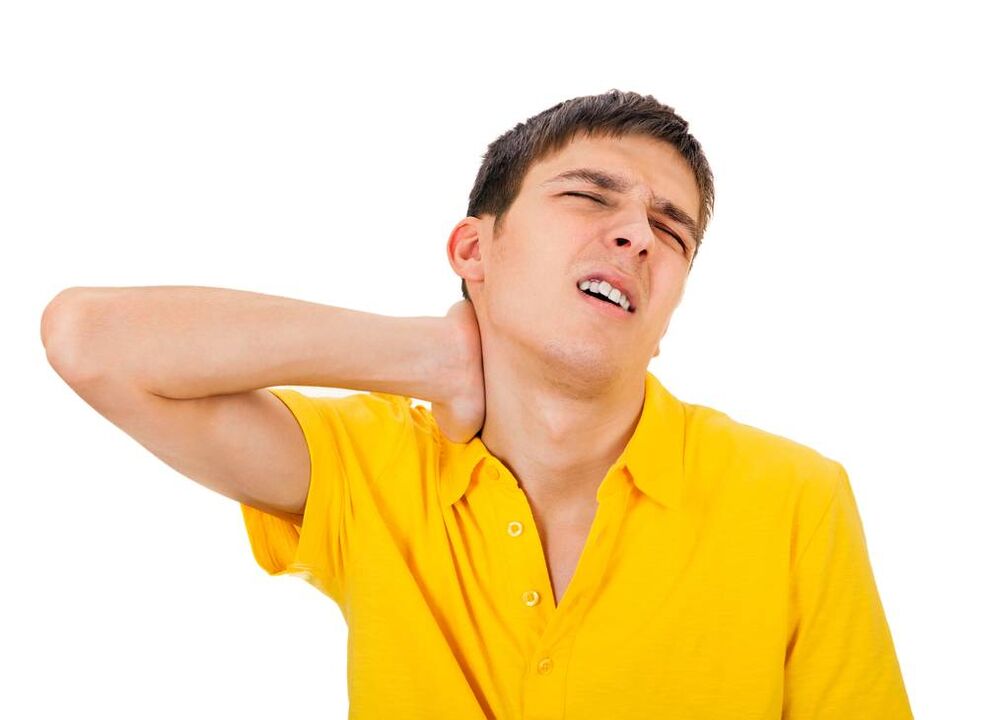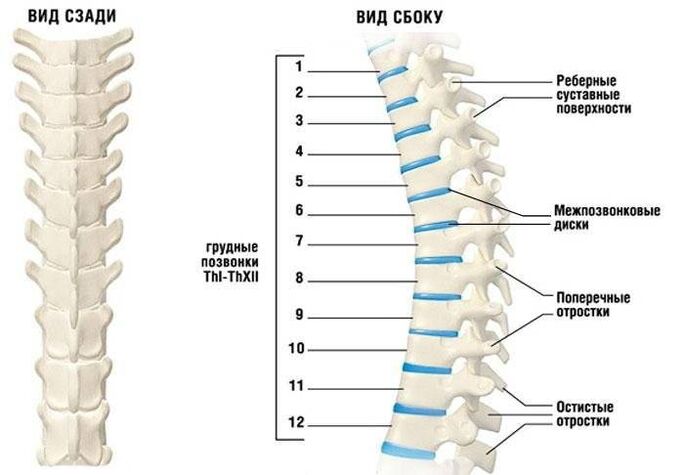At present, according to medical statistics, almost everyone over 25-30 years complain about the symptoms of cervical osteochondrosis.This disease more often affects this spine than others.Pathology is a progressive degenerative process that affects intervertebral and vertebral discs located in the neck.This disease is common among the same men and women.This is a dangerous and complex form of osteochondrosis, because large blood vessels that supply the brain and a large number of nerve endings are located in the neck.Nervous violations and blood flow cause damage to the brain against oxygen and nutrition.

Signs of disease
Symptoms of the neck spine osteochondrosis are clearer than in other parts of the spinal column, even with mild damage.This is caused by the fact that in the vertebral neck is located near each other, and the intervertebral disc has a small height.Such anatomical features contribute to the fact that with osteochondrosis, nerve endings, spinal cord, blood vessels are more often compressed.
Common symptoms:
- pain syndrome;
- weaknesses and decreased sensitivity in the upper limb;
- Limitation of neck mobility;
- violation of the coordination of the movement;
- often dizzy;
- general weakness;
- Damage to the function of perception organs (hearing, vision, touch, taste).
Pain is more often localized in the neck, give them back, shoulders, arms.The upper limb if the nerve spine is pinched by a damaged vertebral, which is responsible for its nervousness.The pain behind the head is due to the spastic contraction of the neck muscles attached to the occipital bone, and violations of blood circulation in this area.
Hand weakness is observed in patients if the nerve spine is involved in a pathological process that ensures the natural structure of the muscles of the upper body.Recovery of mobility and crunch characteristics when the neck is rotated or tilted appears if bone growth appears in the cervical vertebra, the height of the intervertebral discs is reduced, the connection located between the affected vertebra.
Vertebrae in the neck has a transverse process that forms a channel where the arteries that feed the brain run.With osteochondrosis of the neck spine, the vertebral is moved, the connective tissue grows on it.This causes cervical artery compression, damage to the blood supply to the cerebellum and the back of the brain.As a result, a person is often dizzy, coordination of movements, general weaknesses.In further cases, if the arteries are involved in the pathological process or highly pushed, the small brain blood supply, the occipital part and the brain stem worsen significantly.In this case, the functionality of the hearing organs and vision, numbness of the tongue and finger is reduced.
Signs of disease depend on which of the eight vertebrae which is influenced by the distribution or inflammatory process.Disorders of sensitivity and movement cause damage to the cerebrospinal roots where certain vertebrals affect.Depending on this, the following manifestations of cervical osteochondrosis are observed:

- First vertebrae - neck and occipital part of the head numbness, the sensitivity is reduced;
- The second - the pain in the crown and the nape of the neck felt;
- Third taste - pain and sensitivity decreases in the neck where the stuck spine is located, the intensity of the sensation of feeling is reduced, and there is a speech disorder;
- The fourth pain radiates in the shoulder, scapula, the patient is disturbed by heart pain, respiratory problems, and the tone of the neck muscles reduced;
- Fifth - Pain is observed in the neck, given on the outer surface of the shoulder;
- Sixth pain in the neck is emitted into the shoulder knife, felt in the forearm and thumb;
- Seventh - Pain is given to the shoulder knife, the back of the shoulder, forearm and finger (from second to fourth);
- The eighth pain spread from the neck to the shoulders, arms and pinky fingers.
Depending on the prevalence of the lesion, four degrees of osteochondrosis of the neck spine are different.This is not a stage of disease, but the severity of symptoms, because of how common the pathological process, what vertebrae is affected.
- At the first level, clinical symptoms do not exist or are manifested at a minimum.Patients complain of a little pain, intensify during the head movement.Treatment that begins at the stage of this disease will be effective.However, people often ignore the symptoms that are disturbing or do not feel it, so they do not consult a doctor.
- Wrapping the pathological process increases symptoms.In the second stage, the pain becomes clearer, give to the upper limbs, shoulder knives.At this stage in the development of the degenerative process, the height of the intervertebral disc is reduced, as a result the nerve fibers are pinched.This is the cause of increased pain.The second level osteochondrosis cervical area is characterized by the appearance of headaches, decreased welfare, decreased work capacity.
- The third level of cervical osteochondrosis is distinguished by the formation of hernias from the affected intervertebral disc.Limited neck mobility, with palpation patients feel severe pain.With the spread of this pathological process, pain becomes constant, radiating to the upper limbs.The muscle tension attached to the occipital bone is felt.Patients complain of often dizzy, general weakness, numbness of hands.
- The fourth level of cervical osteochondrosis is diagnosed when the intervertebral disc is completely destroyed by the distribution process.This was replaced by a fibrous network, which led to significant mobility limitations.The spinal cord and blood vessels that fly in the neck are affected.Such changes are characterized by significant damage in blood supply to the cerebellum and occipital of the brain.Hunger oxygen causes violations of coordination of movements, hearing loss, vision, language, speech disorders.
Treatment method
Timely looking for a doctor when a worrying symptoms first arise, unpleasant sensation in the neck, the reaction of the nervous system will prevent the development of degenerative changes.Cervical osteochondrosis treatment consists of the therapeutic action complex.Among them:
- take medicine;
- massage;
- Physiotherapy Physical Education;
- Physiotherapy procedure.
Drug therapy
The doctor prescribes anti -inflammatory drugs to reduce the intensity of pain, reduce the process of inflammation and swelling of the nerve spine.The chronicle returns damaged cartilage tissue in the intervertebral disk.Musorelaxants relax the neck muscles, remove seizures.Medication to increase blood flow helps continue blood supply disorders to the brain.Vitamin B activates metabolism in nerve tissue.With severe pain, the doctor can prescribe analgesic drugs.If the patient has a real pain syndrome, the analgesic is inserted parenterally, after the pain subsides, they turn to the tablet.
Physiotherapy method
Physiotherapy is an effective way to fight the osteochondrosis of the cervical area.It is very important to treat this disease using such techniques, followed by the following results achieved:
- The intensity of pain is reduced;
- Recovery of affected bone, cartilage and muscles are activated;
- Seizures and tension in the muscles are removed;
- The inflammatory process was stopped;
- Delivery of oxygen and nutrition to the affected area and the brain improves.
The most effective in the treatment of osteochondrosis is the following type of procedure:
- Drug electrophoresis (the affected area acts with electric sting, which, in addition to activating blood flow and tissue recovery, increases the delivery of drug acting substances to the tissue that is influenced by the degenerative process);
- Ultrasound therapy (metabolic processes in the affected area, reduced pain, inflammation is stopped);
- magnetotherapy (relieve swelling of the affected area, which helps reduce the intensity of pain);
- Laser therapy (increasing blood circulation in the pathological process, has an anti -inflammatory effect).
Medical physical education
The exercise is prescribed during the period when the acute manifestation of the disease is stopped.As long as the exercise should not feel uncomfortable and painful.The complex must be done after reaching the continuous remission to prevent recurrence.

- Take a lying position in the stomach, lift your head and body, lean on your hands.The back is straight, his breath deep and even.Located in a position for one or two minutes, then slowly take the initial position.The number of repetitions is 3.
- Position lying in the stomach, hands along the body.Slowly turn your head, try to touch your ears to the floor.Repeat 6 times on each side.
- Sitting or standing, tilt your head with inhalation, trying to reach your chin to the chest.When exhaling, take your head smoothly, raise your eyes to the sky.The number of repetitions is 10-15.
- A good exercise to strengthen the cervical muscles is to press the forehead to the hands that are pressed there.To achieve the effect, you need to press your palms on the forehead and forehead in your palm for 30 seconds.Repeat three times.
- Turn your head in a circle.Do the exercise slowly, smoothly.In each direction - each revolution.Dizziness during unacceptable movement.If this happens, you must stop immediately.
Massage
This course is prescribed by a doctor during the absence of acute pain, only a specialist with medical education that can do it.With such a disease, it is not recommended to contact non -professional.
Therapeutic effects of the collar area massage:
- blood flow and lymph in the affected area increases;
- Relaxed muscles, seizures are removed;
- The intensity of pain is reduced.
Surgical intervention
This operation is shown if conservative therapy does not carry results within six months, the patient is tortured by severe pain, signs of damage to nerve fibers and myelopathy are observed.If the osteochondrosis of the cervical area continues with complications, there is a stroke threat, there is a strong juice from the spinal cord, then the surgery is needed.
According to indications, they use the following type of surgical intervention:
- Endoscopy discoktomy - the removal of parts or all intervertebral discs;
- Laminotomy - excision of bone ligaments and bone tissue particles overgrown (often combined with laminoplasty - the formation of artificial plates to expand the spinal canal);
- Laser evaporation of the disk nucleus - breakdown of intervertebral disc nucleus with laser beams simultaneously with the destruction of its destroyed fragments;
- Cold nucleoplasty -plasma -Lalih -IH Endoscope, long and thin hollow needles are used, which are inserted into the intervertebral discs, electrodes that have cold -coated effects are sent through it to the location of destruction.
The neck is a complex organs where large blood vessels, spinal cord passes.They are easily damaged, so they use operations no more than 5% of cases.Surgical treatment is often accompanied by the development of complications.Among them:
- the process of inflammation in the spinal cord tissue or membrane;
- osteomyelitis;
- The formation of scars leading to narrowing of the arterial canal and spine.
Surgery in the neck spine complex and requires a long rehabilitation period.Recovery of the patient after surgery takes six months or more.
Prevention
To prevent the development of cervical osteochondrosis, it is necessary:
- Monitor the position of the spine and neck;
- Lead an active lifestyle, move more;
- When doing physical exercise, it is necessary to be careful, to observe the truth of the execution, because even mild injuries can affect the condition of the musculoskeletal system;
- Keep the correct body position during sleep, buy an orthopedic or anatomy mattress;
- Complete the workplace correctly where someone spends a lot of time;
- regularly involved in physical culture;
- Monitor diet, make sure the acceptance of all useful minerals needed for bone fortresses, especially magnesium and calcium;
- Continue to undergo pharmacy examination to detect osteochondrosis on time.
Prevention will help prevent degenerative changes in the neck spine, protect from pain, dizziness, numbness of limbs and other unpleasant symptoms.



















































